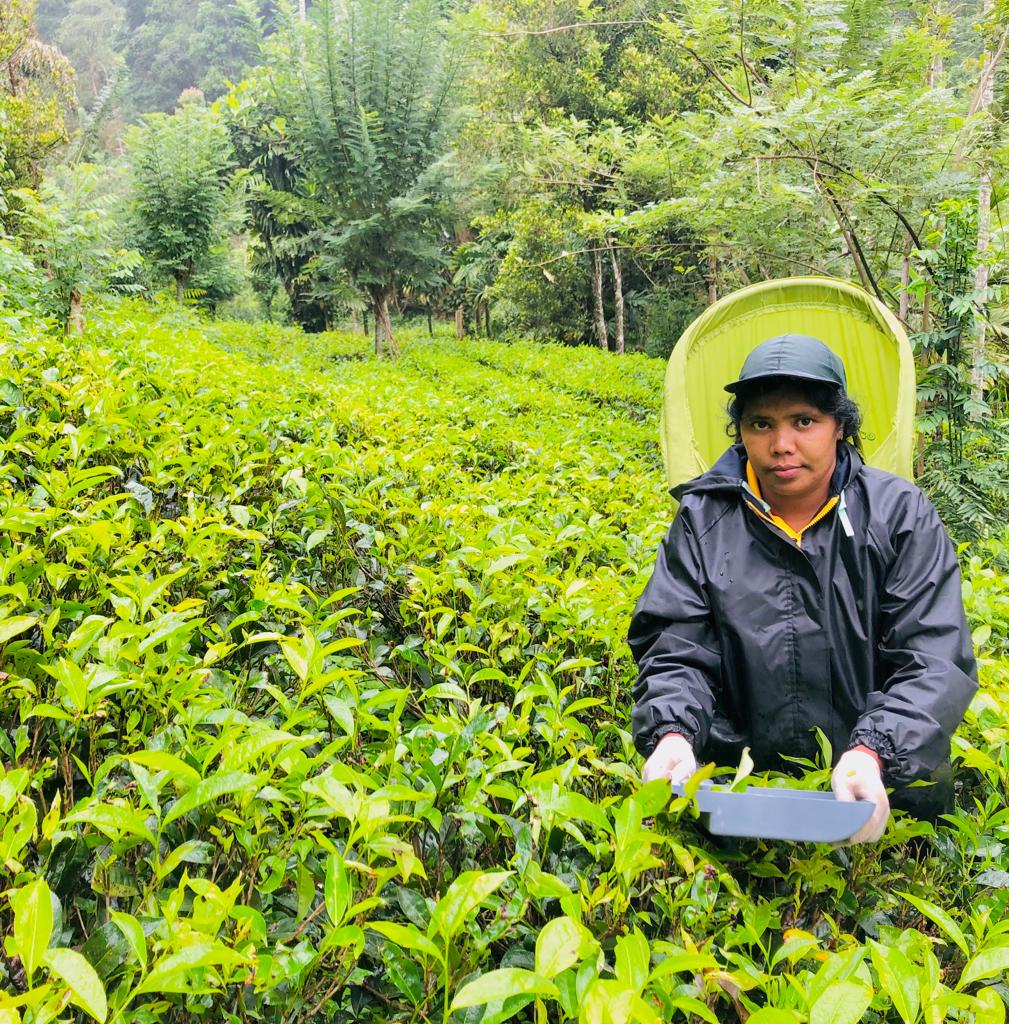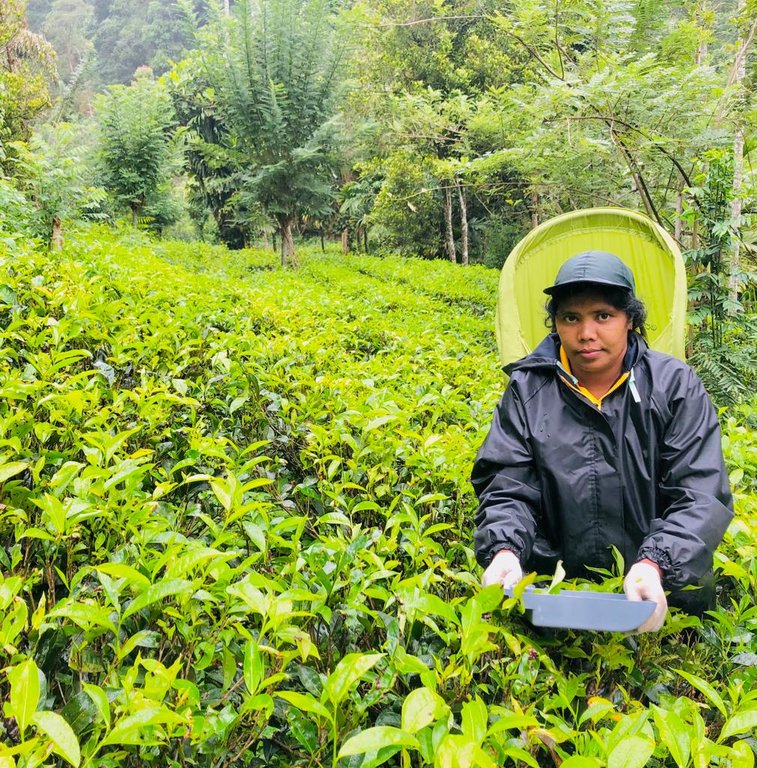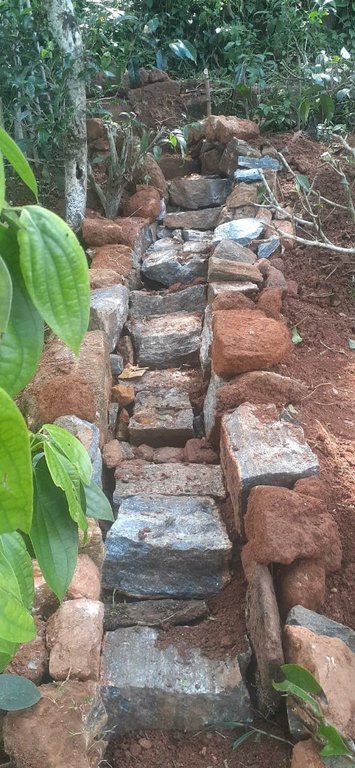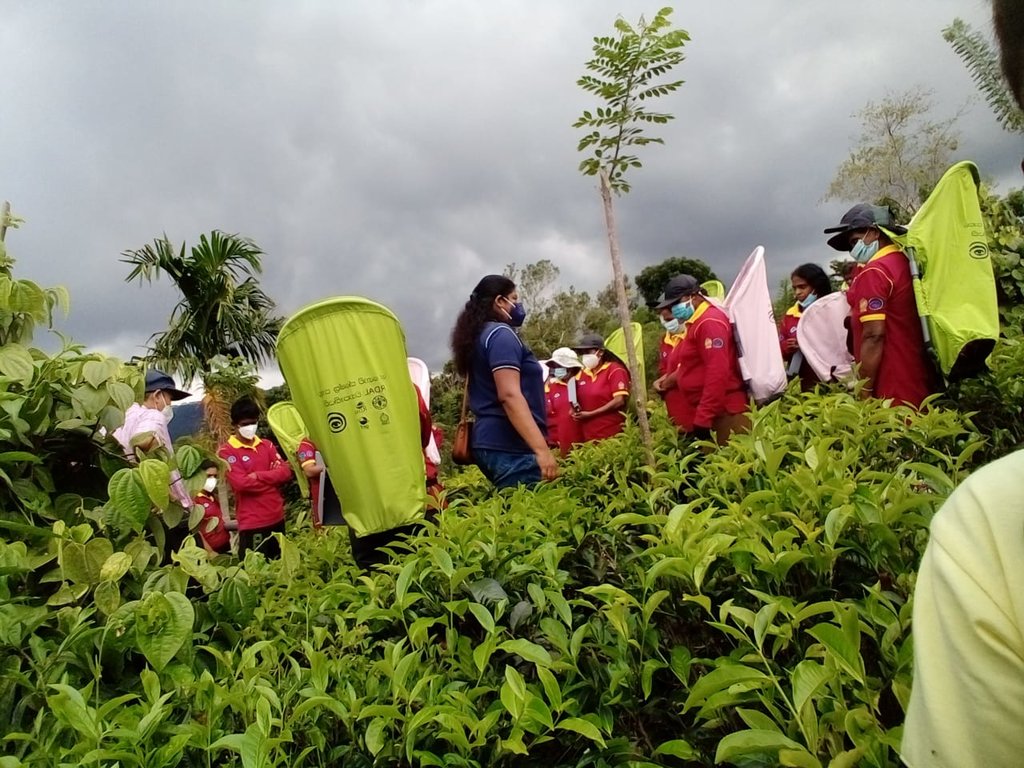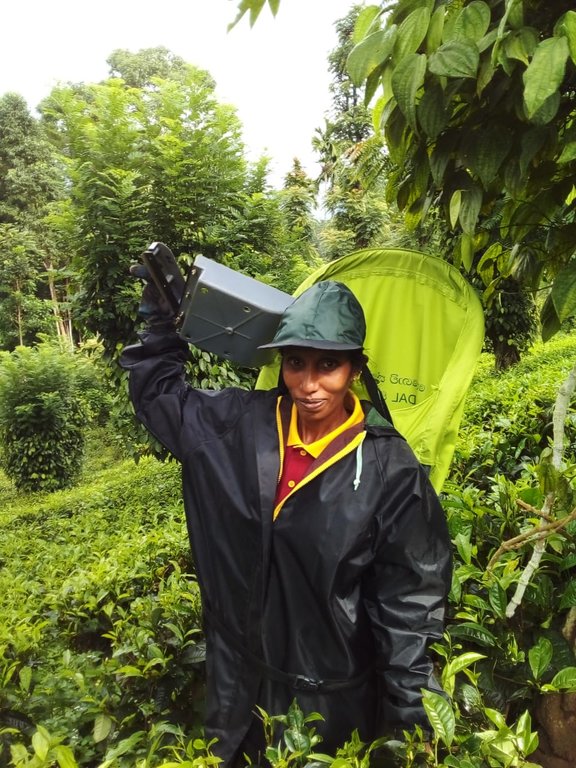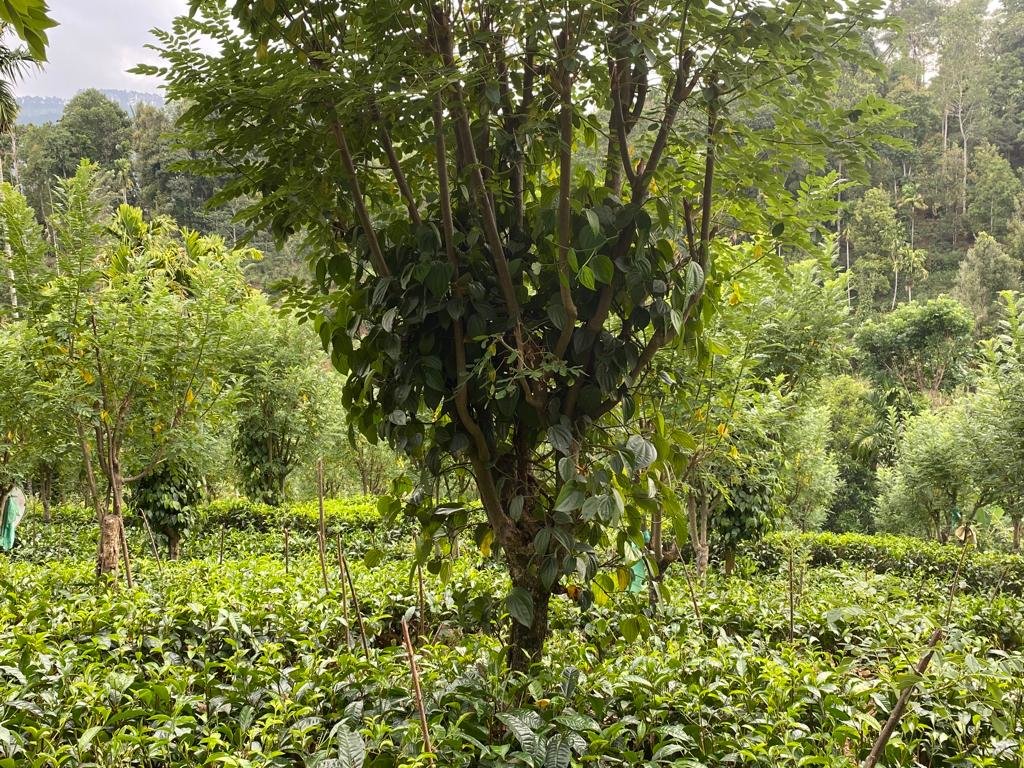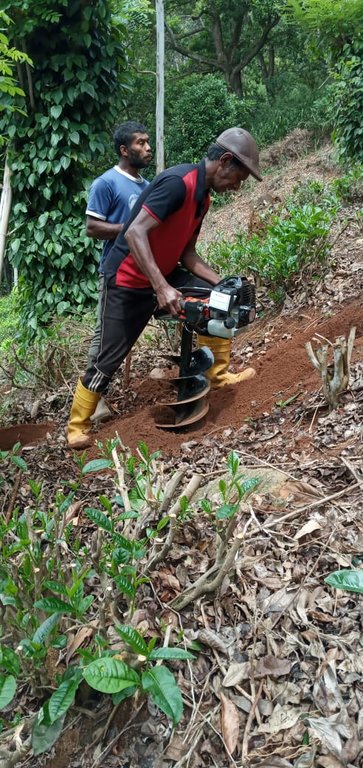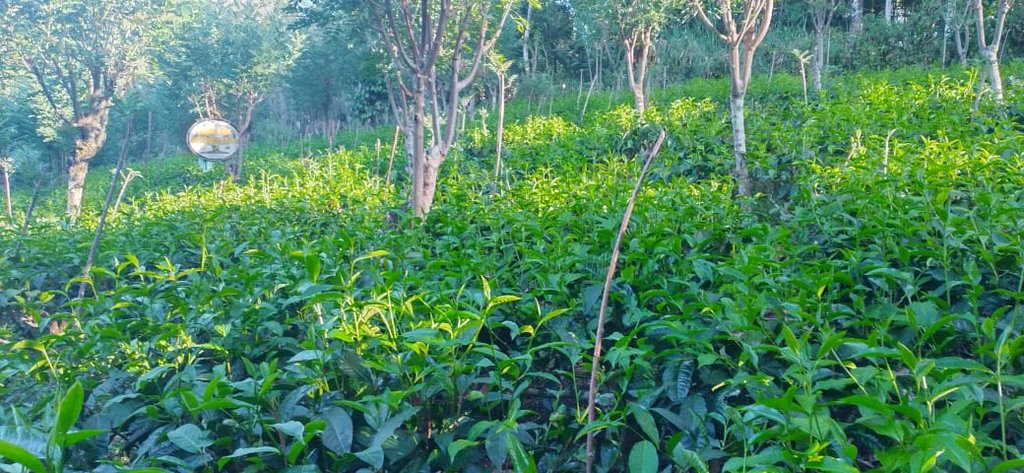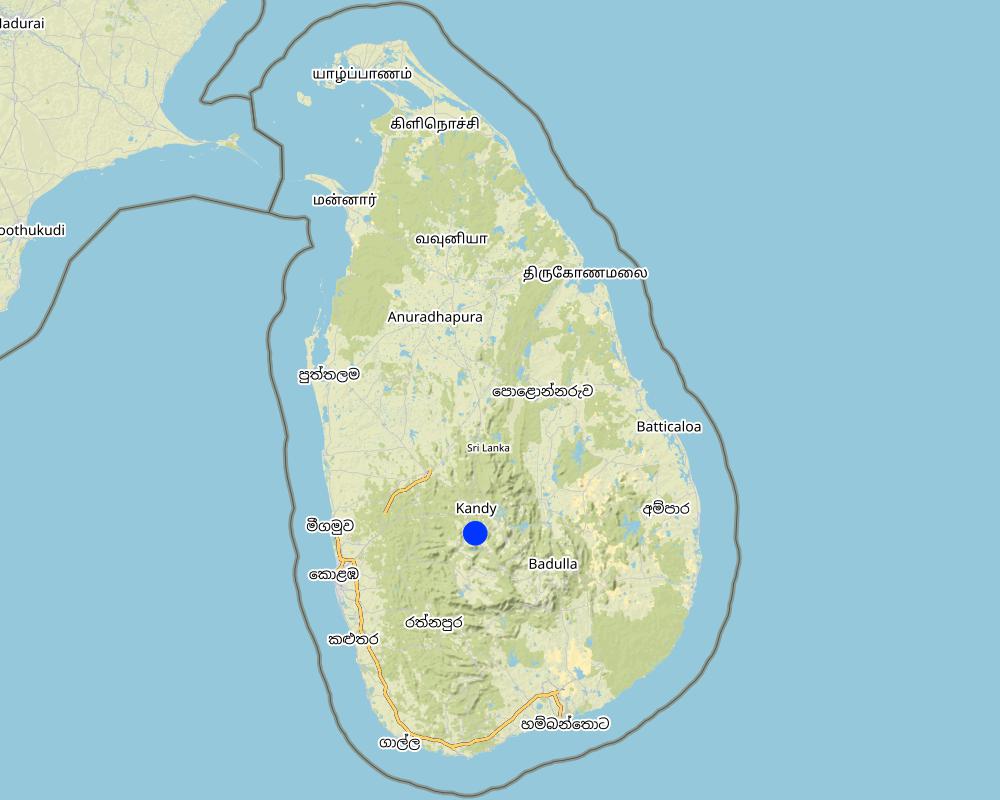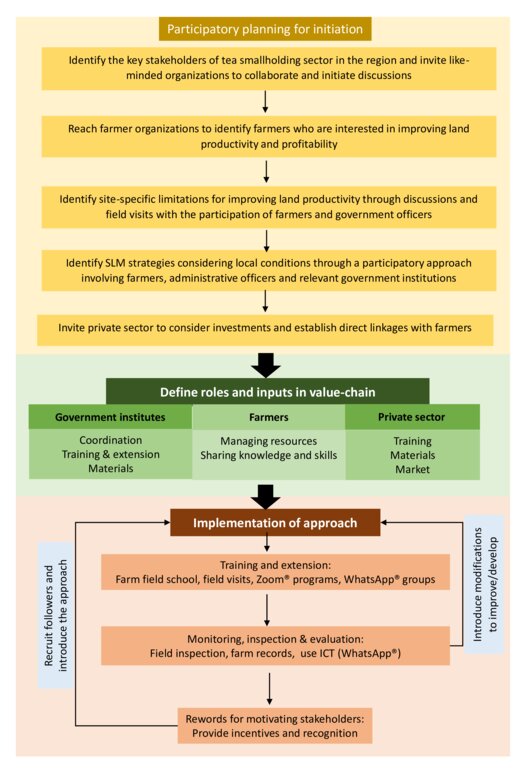Inter-sectoral collaboration for sustainable land management in tea smallholdings [ប្រទេសស្រីលង្កា]
- ការបង្កើត៖
- បច្ចុប្បន្នភាព
- អ្នកចងក្រង៖ Head Soil Science
- អ្នកកែសម្រួល៖ –
- អ្នកត្រួតពិនិត្យច្រើនទៀត៖ William Critchley, Rima Mekdaschi Studer
Inter-sectoral collaboration for sustainable land management in tea smallholdings
approaches_6182 - ប្រទេសស្រីលង្កា
ពិនិត្យមើលគ្រប់ផ្នែក
ពង្រីកមើលទាំងអស់ បង្រួមទាំងអស់1. ព័ត៌មានទូទៅ
1.2 ព័ត៌មានលម្អិតពីបុគ្គលសំខាន់ៗ និងស្ថាប័នដែលចូលរួមក្នុងការវាយតម្លៃ និងចងក្រងឯកសារនៃវិធីសាស្ត្រផ្សព្វផ្សាយ
co-compiler:
co-compiler:
Agrarian Research and Production Assistant:
Iroshini Senevirathna
+94778278582
iroshinisenavirathna@gmail.com
Department of Agrarian Development
Agrarian Research and Production Assistant Office, "Nila Sewana", Pambadeniya
ប្រទេសស្រីលង្កា
អ្នកប្រើប្រាស់ដី:
Pushpa Ranjani
+94767817221
“Sithamu Ranliya” farmer's organization
Pambadeniya, Panvilathanna
ប្រទេសស្រីលង្កា
ឈ្មោះគម្រោងដែលបានចងក្រងឯកសារ/ វាយតម្លៃលើវិធីសាស្ត្រផ្សព្វផ្សាយ (បើទាក់ទង)
Rehabilitation of Degraded Agricultural Lands in Kandy, Badulla and Nuwara Eliya Districts in the Central Highlands of Sri Lankaឈ្មោះអង្គភាពមួយ (ច្រើន) ដែលបានចងក្រងឯកសារ/ វាយតម្លៃលើវិធីសាស្ត្រផ្សព្វផ្សាយ (បើទាក់ទង)
Faculty of Agriculture, University of Peradeniya, Sri Lanka (AGRI.PDN) - ប្រទេសស្រីលង្កា1.3 លក្ខខណ្ឌទាក់ទងទៅនឹងការប្រើប្រាស់ទិន្នន័យដែលបានចងក្រងតាមរយៈវ៉ូខេត
តើពេលណាដែលទិន្នន័យបានចងក្រង (នៅទីវាល)?
25/02/2022
អ្នកចងក្រង និង(បុគ្គលសំខាន់ៗ)យល់ព្រមទទួលយកនូវលក្ខខណ្ឌនានាទាក់ទងទៅនឹងការប្រើប្រាស់ទិន្នន័យដែលបានចងក្រងតាមរយៈ វ៉ូខេត:
បាទ/ចា៎
2. ការពណ៌នាអំពីវិធីសាស្ត្រផ្សព្វផ្សាយ SLM
2.1 ពណ៌នាសង្ខេបខ្លីពីវិធីសាស្ត្រផ្សព្វផ្សាយ
Participatory land restoration with the collective efforts of different stakeholders can assure sustainable use of land-resources. This approach promoted sustainable land management technologies such as agroforestry, soil conservation, and soil fertility enhancement practices through inter-sectoral collaboration, including the use of digital tools and Farmer Field Schools (FFS) to provide training and resources, disseminate knowledge, improve market-orientation of farmers, and monitor and evaluate the progress of activities for rehabilitating and increasing the productivity of degraded tea smallholdings in the Central Highlands of Sri Lanka.
2.2 ពណ៌នាលម្អិតពិវិធីសាស្ត្រផ្សព្វផ្សាយ
ពណ៌នាលម្អិតពិវិធីសាស្ត្រផ្សព្វផ្សាយ:
Due to unsustainable land management practices the monthly average green-leaf yield of tea smallholdings in Maligamale watershed in the Central Highlands of Sri Lanka is as low as 1000 kg/hectare, whereas the potential is 2400 kg/hectare. Soil erosion, soil fertility decline, low plant density, and poor shade management are among the main reasons for low productivity. This causes reduced household incomes and farmers’ ability to invest in sustainable land management (SLM) practices. Inefficiencies in top-down extension methodology, lack of awareness and training on tea cultivation techniques, poor business practices, lack of access to services and poor perceptions about SLM have reduced profit margins of tea smallholdings. Hence, the aim/ objectives of the approach are to increase the land productivity in tea smallholdings and increase farmer’s incomes and gain environmental benefits through proper implementation of SLM practices. To address this, the Rehabilitation of Degraded Agricultural Land Project (RDALP) introduced a participatory approach together with Tea Smallholdings Development Authority (TSHDA), Department of Agrarian Development and other relevant government institutions, the private sector and farming community. The approach considered methods for strengthening linkages between stakeholder groups, providing training and resources for SLM practices, enhancing market orientation, using ICT for knowledge sharing, monitoring and evaluation, improving perceptions of farming community on agriculture and enhancing food-security of the households.
Firstly, tea smallholders who volunteered to learn about SLM were linked with the experts to collectively develop a participatory land restoration proposal. Site specific limitations for productivity improvement, recommendations, roles of different stakeholders, and training and material needs were identified in the proposal. The existing institutional setup was used for coordination of activities. The experts from government institutes provided training on SLM through farmer field schools, field demonstrations and ICT tools. More specifically, farmers were educated on soil conservation and soil fertility management practices: these included producing organic fertilizers using locally available resources, building live fences with green-manure crops and edible crops, intercropping using export agriculture crops, in-filling, selective weeding, developing and maintaining nurseries, using machinery for cutting pits and harvesting, using safety measures during field operations, and shade tree management. In addition, farmers have been encouraged to share good-practices, keep records and practice soil test-based decision making for nutrient management. Farmers and officers effectively used WhatsApp®, Zoom® and Facebook® for knowledge sharing and for monitoring and evaluating progress. Dissemination of knowledge using ICT and performance-based rewarding helped to recruit more farmers as followers. The TSHDA supported with extension service and regular monitoring of progress. With the support of government institutes, farmers were linked with private sector companies to promote market orientation. Export agriculture crops such as peppers, vanilla, areca nut and cloves were successfully incorporated into tea smallholding landscape, allowing farmers to earn an extra income. The partners from the private sector provided planting materials and extension services to transfer necessary knowledge and skills to the farmers. Machinery was provided to farmer organizations for the members to share.
Improving profitability of farming, improving hygiene and safety of farmers, and reducing time spent on agronomic practices have uplifted the living-status of famers and increased their willingness to invest in SLM. These characters could attract youth to the sector.
2.3 រូបភាពនៃវិធីសាស្ត្រផ្សព្វផ្សាយ
2.4 វីឌីអូនៃវិធីសាស្ត្រផ្សព្វផ្សាយ
ការពណ៌នាសង្ខេប:
https://www.youtube.com/watch?v=SU3--fHKY1k
Application of ICT for knowledge dissemination and agricultural extension service
កាលបរិច្ឆេទ:
20/07/2021
ទីតាំង:
Pambadeniya, Panvilathanna
2.5 ប្រទេស/តំបន់/ទីតាំងកន្លែង ដែលវិធីសាស្ត្រផ្សព្វផ្សាយត្រូវបានអនុវត្តន៍
ប្រទេស:
ប្រទេសស្រីលង្កា
តំបន់/រដ្ឋ/ខេត្ត:
Kandy District- Central Province
បញ្ជាក់បន្ថែមពីលក្ខណៈនៃទីតាំង:
Pambadeniya village
មតិយោបល់:
The region is in the Maligamale watershed in the Central Highlands of Sri Lanka.
Map
×2.6 កាលបរិច្ឆេទនៃការចាប់ផ្តើម និងបញ្ចប់នៃវិធីសាស្រ្តផ្សព្វផ្សាយនេះ
សូមបញ្ជាក់ឆ្នាំដែលបានបង្កើតឡើង:
2017
មតិយោបល់:
Approach is still carrying out by land user
2.7 ប្រភេទនៃវិធីសាស្ត្រផ្សព្វផ្សាយ
- ផ្អែកលើគម្រោង/កម្មវិធី
2.8 គោលបំណង/ទិសដៅសំខាន់នៃវិធីសាស្ត្រផ្សព្វផ្សាយ
The aims/ objectives of the approach are to increase the land productivity in tea smallholdings and increase farmers' income and environmental benefits through proper implementation of SLM practices.
2.9 លក្ខខណ្ឌអនុញ្ញាត ឬរារាំងការអនុវត្តន៍បច្ចេកទេសដែលស្ថិតនៅក្រោមវិធីសាស្រ្តផ្សព្វផ្សាយ
សង្គម/វប្បធម៌/ និងតម្លៃនៃសាសនា
- អំណោយផល
Increased livelihood requirements and access to education, market and health services
- រារាំង
Migration of youth and males to cities
ភាពអាចរកបាននៃធនធានហិរញ្ញវត្ថុ និងសេវាកម្ម
- អំណោយផល
Providing funds/ subsidies has increased the access to financial resources (subsidy schemes of TSHDA, Loan facilities of tea factories)
- រារាំង
Access of farmers to resources is limited by their financial situation as well as geographic location.
បរិបទនៃស្ថាប័ន
- អំណោយផល
An institutional set-up for facilitating the approach already exists and all technical support is providing by institutes
- រារាំង
Mandate of some institutions are not clearly defined. Decision making is very often a top-down approach
ការសហការ/ការសម្របសម្រួលតួអង្គពាក់ព័ន្ធ
- អំណោយផល
Institutes have some level of collaboration
- រារាំង
There is lack of motivation to initiate collaboration and the level of collaboration depends on the commitments of the officers. Institutional mechanisms do not encourage the collaborations
ក្របខណ្ឌច្បាប់ (សិទ្ធិកាន់កាប់ដីធ្លី កម្មសិទ្ធីប្រើប្រាស់ដីនិងទឹក)
- អំណោយផល
Some land users own their land
- រារាំង
Some lands used by farmers are owned by the state and there are issues on land rights. Water availability is problematic to farmers as the crop is maintained as a rainfed crop. In the region, drinking water is supplied in ten days interval during dry-months
គោលនយោបាយ
- អំណោយផល
National soil conservation act
- រារាំង
Implementation of policies to action is very low
អភិបាលកិច្ចដី (ការសម្រេចចិត្ត ការអនុវត្ត និងការរឹតបន្តឹង)
- អំណោយផល
Farmers participated in the decision-making process related to land management. Land is maintained based on the advice given under the approach. Most of the technologies introduced were not gender biased and therefore, involvement of women in management practices increased
- រារាំង
Dependence on males is high for agronomic practices in tea-cultivation
ចំណេះដឹងស្តីពី SLM និងការទទួលបានការគាំទ្រផ្នែកបច្ចេកទេស
- អំណោយផល
Farmers were guided through farmer training programs, practical sessions, farmer field schools, Zoom® meetings, sharing knowledge through WhatsApp® groups and Facebook.
- រារាំង
Shortage of tea extension officers
ទីផ្សារ (ទិញធាតុចូល លក់ផលិតផល) និងតម្លៃ
- អំណោយផល
Private companies come to fields to purchase products and they provide extension support and material inputs to some extent to the farmers who have established links with them
- រារាំង
Market orientation of farmers is low and their ability to negotiate prices is poor due to various factors
ទំហំការងារ ភាពអាចរកបាននៃកម្លាំងពលកម្ម
- អំណោយផល
Labour resources are available. Introduction of machinery created shared responsibilities and reduced labour demand while creating an income source for the farmer organizations. Decent working environment with safety kits and machineries will encourage the labour force to remain in the sector
- រារាំង
Labour force continuously moving away from the industry
3. ការចូលរួម និងតួនាទីរបស់ភាគីពាក់ព័ន្ធ
3.1 អ្នកពាក់ព័ន្ធដែលបានចូលរួមក្នុងវិធីសាស្ត្រផ្សព្វផ្សាយ និងតួនាទីរបស់ពួកគេ
- អ្នកប្រើប្រាស់ដីក្នុងតំបន់/សហគមន៍
Men and women farmers are involved in tea cultivation
They involved in practicing SLM technologies as the technologies were not gender biased. But the operation of mechanical weeder and auger for infilling are mainly done by male farmers.
- អង្គការសហគមន៍មូលដ្ឋាន
Farmer organizations
Support coordination of activities with farmers
Support Farmer Field Schools
Maintain common equipment and rent for members and non-members to support SLM practices
- អ្នកឯកទេសគ្រប់គ្រងដីប្រកបដោយចីរភាព/ទីប្រឹក្សាបច្ចេកទេសកសិកម្ម
Tea Smallholding Development Authority, Department of Agrarian Development, Department of Export Agriculture, Department of Agriculture
Provide tea plants for infilling, promote inter-cropping and provide technical guidance to farmers
Serve as resource-persons in Farmer Field Schools and in WhatsApp® groups
- អ្នកស្រាវជ្រាវ
University of Uva Wellassa, Sri Lanka
Study the effectiveness of knowledge dissemination approach and effectiveness of some SLM technologies
- វិស័យឯកជន
Several private sector companies are involved (Bio Food (Pvt) Ltd, Adamjee Lukmanjee (Pvt) Ltd)
Buying products, providing planting materials and continuing extension services to transfer necessary knowledge and skills to the farmers who are linked with them
- រដ្ឋាភិបាលថ្នាក់មូលដ្ឋាន
Local government institutes are involved in the process (Tea Smallholdings Development Authority (TSHDA), Department of Agrarian Development, Department of Agriculture, Department of Export Agriculture, Divisional Secretariat office- Doluwa
Capacity building, advisory services on fertilizer usage, land management, crop selection etc.
- រដ្ឋាភិបាលថ្នាក់ជាតិ (អ្នករៀបចំផែនការ អ្នកសម្រេចចិត្ត)
Ministry of Environment
Helps to raise awareness among private and government sector stakeholders and within communities about SLM approaches and technologies,
Project coordination and partial financial support
- អង្គការអន្តរជាតិ
Food and Agriculture Organization of the United Nations
Project coordination, partial financial support and capacity building
ប្រសិនមានភាគីពាក់ព័ន្ធច្រើនចូលរួមសូមចង្អុលបង្ហាញភ្នាក់ងារដែលនាំមុខគេ:
Tea Smallholdings Development Authority (TSHDA)
3.2 ការចូលរួមរបស់អ្នកប្រើប្រាស់ដីក្នុងតំបន់/ សហគមន៍ក្នុងតំបន់ក្នុងដំណាក់កាលផ្សេងគ្នានៃវិធីសាស្រ្តផ្សព្វផ្សាយ
| ការចូលរួមរបស់អ្នកប្រើប្រាស់ដីក្នុងតំបន់/សហគមន៍ក្នុងតំបន់ | សូមបញ្ជាក់នរណាត្រូវបានចូលរួម ព្រមទាំងពណ៌នាសកម្មភាពទាំងនោះ | |
|---|---|---|
| ការចាប់ផ្តើម/ការលើកទឹកចិត្ត | អន្តរកម្ម | Government agencies, representatives from farmer organizations, RDALP team. Discussions to develop participatory land use plans for a region and identify the sectors to be developed |
| ការរៀបចំផែនការ | អន្តរកម្ម | Government agencies, representatives from farmer organizations, RDALP team Discussions, site visits and field programs to identify factors limiting land productivity and implementation of SLM practices Identify strategies to address these limitations Identify how the private sector can contribute and invite them to invest |
| ការអនុវត្តន៍ | អន្តរកម្ម | Government agencies, leaders of farmer organizations, farmers, RDALP team, private sector companies Training and dissemination of knowledge through demonstrations, farmer training programs, farmer field schools Progress monitoring and evaluation Provide advisory services to farmers as needed Conduct performance-based rewarding to motivate the practitioners and to recruit followers |
| ការត្រួតពិនិត្យ និងវាយតម្លៃ | អន្តរកម្ម | TSHDA, RDALP team, farmers, private sector companies make observations in fields, guiding land users, exchange photos through whatsapp® Some private sector companies also involve in monitoring and field evaluating process (Adamjee Lukmanjee (Pvt) Ltd) |
3.3 គំនូសបំព្រួញ (ប្រសិនបើមាន)
ការពណ៌នា:
Before implementing the approach the level of productivity of tea lands that belong to the farmers who participated in the project were in class ‘C’ and below. In this scale of productivity lands were classified from A to D where A is the best and D is the worst. After implementation of the approach most of the fields upgraded to ‘A’ and ‘B’ performance levels. An interview conducted with a farmer revealed that the average green-leaf tea yield before and after participating in the approach were 1000 kg/ha/month and 2400 kg/ha/month, respectively.
អ្នកនិពន្ធ:
Warshi S. Dandeniya
3.4 ការសម្រេចចិត្តលើការជ្រើសរើសបច្ចេកទេស SLM
សូមបញ្ជាក់តើអ្នកណាជាអ្នកបានសម្រេចចិត្តក្នុងការជ្រើសរើសបច្ចេកទេសដើម្បីយកមកអនុវត្តន៍:
- គ្រប់ភាគីពាក់ព័ន្ធទាំងអស់ដែលជាផ្នែកនៃវិធីសាស្រ្តផ្សព្វផ្សាយដោយមានការចូលរួម
សូមបញ្ជាក់ តើការសម្រេចធ្វើឡើងដោយផ្អែកលើអ្វីជាមូលដ្ឋាន:
- វាយតម្លៃទៅលើចំណេះដឹងស្តីអំពី SLM ដែលបានចងក្រងជាឯកសារបានត្រឹមត្រូវ (ផ្អែកលើភស្តុតាងជាមូលដ្ឋានដើម្បីសម្រេចចិត្ត)
- លទ្ធផលបានពីការស្រាវជ្រាវ
- បទពិសោធន៍ និងគំនិតផ្ទាល់ខ្លួន(ពុំមានចងក្រងជាឯកសារ)
4. ជំនួយបច្ចេកទេស ការកសាងសមត្ថភាព និងការគ្រប់គ្រងចំណេះដឹង
4.1 ការកសាងសមត្ថភាព/ បណ្តុះបណ្តាល
តើវគ្គបណ្តុះបណ្តាលបានផ្តល់ឱ្យអ្នកប្រើប្រាស់ដី/អ្នកពាក់ព័ន្ធផ្សេងៗទៀតដែរឬទេ?
បាទ/ចា៎
សូមបញ្ជាក់តើអ្នកណាត្រូវបានបណ្តុះបណ្តាល:
- អ្នកប្រើប្រាស់ដី
- បុគ្គលិកចុះទីវាល/អ្នកផ្តល់ប្រឹក្សាយោបល់
ប្រសិនទាក់ទង សូមបញ្ជាក់ ភេទ អាយុ ស្ថានភាពគ្រួសារ ជនជាតិដើមភាគតិច។ល។:
Training was provided for both men and women; age between 20-70 years old
ទម្រង់នៃការបណ្តុះបណ្តាល:
- ពីកសិករទីកសិករ
- ទីតាំងបង្ហាញ
- ការប្រជុំជាសាធារណៈ
- វគ្គបណ្តុះបណ្តាល
ទម្រង់នៃការបណ្តុះបណ្តាល:
- Zoom discussions, Farm Field Schools
ប្រធានបទបណ្តុះបណ្តាល:
Soil conservation practices, intercropping in tea lands, organic fertilizer preparation (compost tea, vermi- compost), burying of pruned plant parts, infilling, documentation, improving tea buds quality and quantity, handling of machines for cutting pits and tea plucking
មតិយោបល់:
Farmer trainings are much important to spread easy agronomic practices and scientific knowledge to farmers
4.2 សេវាផ្តល់ប្រឹក្សាយោបល់
តើអ្នកប្រើប្រាស់ដីបានទទួលនូវសេវាផ្តល់ប្រឹក្សាដែរ ឬទេ?
បាទ/ចា៎
សូមបញ្ជាក់ប្រសិនបើសេវាកម្មប្រឹក្សាយោបល់ត្រូវបានផ្តល់ឱ្យ:
- នៅលើដីរបស់អ្នកប្រើប្រាស់ដី
ពណ៌នា/ពន្យល់:
Demonstration, advisory service was carried out through: government extension system, agricultural instructors and some private sector companies such as Adamjee Lukmanjee (Pvt) Ltd company which is giving support to enhance vanilla cultivation as an intercrop
4.3 ការពង្រឹងសមត្ថភាពស្ថាប័ន (ការអភិរឌ្ឍន៍អង្គភាព)
តើស្ថាប័នទាំងអស់ត្រូវបានបង្កើតឡើង ឬពង្រឹងសមត្ថភាពតាមរយៈវិធីសាស្ត្រផ្សព្វផ្សាយដែរ ឬទេ?
- បាទ/ច៎ា ជាមធ្យម
សូមបញ្ជាក់ថាតើស្ថាប័នត្រូវបានពង្រឹង ឬបង្កើតឡើងនៅត្រឹមកម្រិតណា(ច្រើន)?
- ថ្នាក់មូលដ្ឋាន
សូមបញ្ជាក់ប្រភេទនៃការគាំទ្រ:
- ការកសាងសមត្ថភាព/ បណ្តុះបណ្តាល
- សម្ភារៈ
- providing safety kits and tea plants for infilling
សូមផ្តល់ព័ត៌មានបន្ថែមទៀតឱ្យបានលម្អិត:
Organizing and conducting training programs, providing machineries for tea plucking and cutting pits, distribute safety kits among land users
4.4 ការត្រួតពិនិត្យ និងវាយតម្លៃ
តើការត្រួតពិនិត្យ និងវាយតម្លៃគឺជាផ្នែកមួយនៃវិធីសាស្ត្រដែរឬទេ?
បាទ/ចា៎
ប្រសិន បាទ/ច៎ា តើឯកសារនេះបានបង្កើតឡើងក្នុងគោលបំណងប្រើប្រាស់សម្រាប់ការត្រួតពិនិត្យ និងវាយតម្លៃដែរឬទេ?
ទេ
4.5 ការស្រាវជ្រាវ
តើការស្រាវជ្រាវ គឺជាផ្នែកមួយនៃវិធីសាស្រ្តដែរឬទេ?
បាទ/ចា៎
បញ្ជាក់ប្រធានបទ:
- បច្ចេកវិទ្យា
5. ថវិកា និងសម្ភារៈឧបត្ថម្ភពីខាងក្រៅ
5.1 ថវិកាប្រចាំឆ្នាំសម្រាប់ផ្សព្វផ្សាយ SLM
ប្រសិនបើចំនួនពិតប្រាកដនៃថវិកាប្រចាំឆ្នាំមិនត្រូវបានដឹងច្បាស់ សូមប្រាប់ពីចន្លោះនៃថវិកានោះ:
- 100,000-1,000,000
5.2 ការគាំទ្រផ្នែកហិរញ្ញវត្ថុ / សម្ភារៈដែលបានផ្តល់ទៅឱ្យអ្នកប្រើប្រាស់ដី
តើអ្នកប្រើប្រាស់ដីបានទទួលការគាំទ្រផ្នែកហិរញ្ញវត្ថ/សម្ភារៈសម្រាប់ការអនុវត្តន៍បច្ចេកទេសដែរឬទេ:
បាទ/ចា៎
ប្រសិនបាទ/ច៎ា សូមបញ្ជាក់ប្រភេទ(ច្រើន)នៃការគាំទ្រ លក្ខខណ្ឌ និងអ្នកផ្តល់ឱ្យ(ច្រើន):
Provide machinery for cutting pits and plucking, safety kits and tea plants for infilling as material support, provide financial support for soil testing, to add liming material for correcting soil pH for those who performed soil testing
The material and financial support was provided by RDALP team with contributions from TSHDA and private sector based on performance evaluation
5.3 សូមបញ្ជាក់ពីធាតុចូលត្រូវបានផ្តល់បដិភាគ (រួមទាំងកម្លាំងពលកម្ម)
- សម្ភារៈ
| សូមបញ្ជាក់ ធាតុចូលណាខ្លះដែលបានផ្តល់បដិភាគ | កម្រិតទំហំប៉ុណ្ណា | សូមបញ្ជាក់ពីការបដិភាគ |
|---|---|---|
| ម៉ាស៊ីន | ផ្តល់ហិរញ្ញវត្ថុទាំងស្រុង | Tea plucking machines, grass cutting machines and machine for cutting pits in tea lands |
| ឧបករណ៍ | ផ្តល់ហិរញ្ញវត្ថុទាំងស្រុង | Tea buds collecting buckets |
- កសិកម្ម
| សូមបញ្ជាក់ ធាតុចូលណាខ្លះដែលបានផ្តល់បដិភាគ | កម្រិតទំហំប៉ុណ្ណា | សូមបញ្ជាក់ពីការបដិភាគ |
|---|---|---|
| Planting materials, liming materials | ផ្តល់ហិរញ្ញវត្ថុទាំងស្រុង | Tea plants for infilling, liming materials to correct soil pH, soil testing service |
- ផ្សេងៗ
| ផ្សេងៗ (បញ្ចាក់) | កម្រិតទំហំប៉ុណ្ណា | សូមបញ្ជាក់ពីការបដិភាគ |
|---|---|---|
| Safety kits | ផ្តល់ហិរញ្ញវត្ថុទាំងស្រុង |
ប្រសិនបើកម្លាំងពលកម្មធ្វើដោយអ្នកប្រើប្រាស់ដី តើវាជាធាតុចូលដ៏សំខាន់មួយដែរ ឬទេ:
- ដោយស្ម័គ្រចិត្ត
មតិយោបល់:
Most of the time family members are engaged with field activities and hire labour for tea plucking
5.4 ឥណទាន
តើឥណទានដែលបានផ្តល់នៅក្រោមវិធីសាស្ត្រផ្សព្វផ្សាយសម្រាប់សកម្មភាព SLM នេះយ៉ាងដូចម្តេច?
ទេ
5.5 ការលើកទឹកចិត្ត ឬវិធីសាស្ត្រដ៏ទៃទៀត
តើមានការលើកទឹកចិត្តផ្សេងទៀត ឬឧបករណ៍ប្រើប្រាស់ដើម្បីលើកកម្ពស់ការអនុវត្តន៍បច្ចេកទេស SLM?
បាទ/ចា៎
6. ការវិភាគរកផលប៉ះពាល់ និងសេចក្តីសន្និដ្ឋាន
6.1 ផលប៉ះពាល់នៃវិធីសាស្ត្រផ្សព្វផ្សាយ
តើវិធីសាស្ត្រផ្សព្វផ្សាយបានផ្តល់សិទ្ធិអំណាចដល់អ្នកប្រើប្រាស់ដី ធ្វើឱ្យប្រសើរឡើងនូវការចួលរួមអ្នកពាក់ព័ន្ធ?
- ទេ
- បាទ/ច៎ា បន្តិចបន្តួច
- បាទ/ច៎ា ជាមធ្យម
- បាទ/ច៎ា បានខ្លាំង
Application of organic fertilizers such as compost tea, vermi-compost enhance the market value and some farmers ventured into organic tea production
តើវិធីសាស្រ្តផ្សព្វផ្សាយនេះអនុញ្ញាតឱ្យធ្វើការសម្រេចចិត្ដដោយផ្អែកលើភស្តុតាងជាមូលដ្ឋានដែរ ឬទេ?
- ទេ
- បាទ/ច៎ា បន្តិចបន្តួច
- បាទ/ច៎ា ជាមធ្យម
- បាទ/ច៎ា បានខ្លាំង
Participatory approach in all stages of the project and farmer field schools encouraged the farmers and officers for evidence-based decision making. This also helped to recruit followers for the approach.
តើវិធីសាស្ត្រផ្សព្វផ្សាយជួយអ្នកប្រើប្រាស់ដីដើម្បីអនុវត្តន៍ និងថែទាំបច្ចេកទេស SLM?
- ទេ
- បាទ/ច៎ា បន្តិចបន្តួច
- បាទ/ច៎ា ជាមធ្យម
- បាទ/ច៎ា បានខ្លាំង
Approach helps to maintain better environment within the community as it introduced practices that improved safety and hygiene of the farmers while being more efficient. Farmers have been maintaining the SLM technologies
តើវិធីសាស្រ្តផ្សព្វផ្សាយនេះធ្វើឱ្យប្រសើរឡើងនូវការសម្របសម្រួលនិងការអនុវត្តចំណាយរបស់ SLMមានប្រសិទ្ធិភាពបែបណា? :
- ទេ
- បាទ/ច៎ា បន្តិចបន្តួច
- បាទ/ច៎ា ជាមធ្យម
- បាទ/ច៎ា បានខ្លាំង
Approach used existing institutional set-up and farmer organizations to coordinate the activities. Therefore, it was cost effective and helped to strengthen the collaborations between stakeholders
តើវិធីសាស្រ្តផ្សព្វផ្សាយនេះប្រមូលផ្តុំ / ធ្វើឱ្យប្រសើរឡើងនូវការទទួលបានធនធានហិរញ្ញវត្ថុសម្រាប់ការអនុវត្ត SLM?
- ទេ
- បាទ/ច៎ា បន្តិចបន្តួច
- បាទ/ច៎ា ជាមធ្យម
- បាទ/ច៎ា បានខ្លាំង
Introducing private sector collaborations and improving market orientation of farmers helped to attract financial support to maintain sustainability of the approach
តើវិធីសាស្ត្រផ្សព្វផ្សាយនេះធ្វើឱ្យចំណេះដឹងប្រសើឡើង និងសមត្ថភាពរបស់អ្នកប្រើប្រាស់ដីក្នុងការអនុវត្តន៏ SLM?
- ទេ
- បាទ/ច៎ា បន្តិចបន្តួច
- បាទ/ច៎ា ជាមធ្យម
- បាទ/ច៎ា បានខ្លាំង
Approach improved the knowledge and capacity of practitioners. Although only about 25 farmers attended farmer field school the number of farmers who joined WhatsApp group is high as 70. Farmers are sharing knowledge and experiences and were able to improve land productivity through the approach
តើវីធីសាស្ត្រផ្សព្វផ្សាយនេះពង្រឹងចំណេះដឹង និងកសាងសមត្ថភាពរបស់អ្នកពាក់ព័ន្ធឬទេ?
- ទេ
- បាទ/ច៎ា បន្តិចបន្តួច
- បាទ/ច៎ា ជាមធ្យម
- បាទ/ច៎ា បានខ្លាំង
The knowledge and capacities of other stakeholders were improved similarly. Several officers were trained on SLM practices and technologies, use of ICT for extension, etc
តើវីធីសាស្ត្រនេះបានជួយកសាង/ពង្រឹងស្ថាប័ន កិច្ចសហប្រតិបត្តិការរវាងអ្នកពាក់ព័ន្ធដែរ ឬទេ?
- ទេ
- បាទ/ច៎ា បន្តិចបន្តួច
- បាទ/ច៎ា ជាមធ្យម
- បាទ/ច៎ា បានខ្លាំង
Approach helps to strengthen the collaboration between institutes and stakeholders
តើវីធីសាស្ត្រផ្សព្វផ្សាយនេះបានកាត់បន្ថយជំលោះឬទេ?
- ទេ
- បាទ/ច៎ា បន្តិចបន្តួច
- បាទ/ច៎ា ជាមធ្យម
- បាទ/ច៎ា បានខ្លាំង
Improving communication through the project supported the stakeholders to build healthy relationships.
តើវិធីសាស្ត្រផ្សព្វផ្សាយនេះផ្តល់សិទ្ធិអំណាចដល់សង្គមនិងសេដ្ឋកិច្ចដែលក្រុមមិនទទួលបានផលប្រយោជន៍?
- ទេ
- បាទ/ច៎ា បន្តិចបន្តួច
- បាទ/ច៎ា ជាមធ្យម
- បាទ/ច៎ា បានខ្លាំង
Approach helps to earn income in different ways. It is not limited for tea. They can earn money by selling the harvest from intercropping such as vanilla, pepper cultivation, managing nurseries, etc.
តើវិធីសាស្ត្រផ្សព្វផ្សាយ បានធ្វើឱ្យប្រសើរឡើងសមភាពយេនឌ័រ និងផ្តល់សិទិ្ធអំណាចដល់ស្ត្រី និងក្មេងស្រី?
- ទេ
- បាទ/ច៎ា បន្តិចបន្តួច
- បាទ/ច៎ា ជាមធ្យម
- បាទ/ច៎ា បានខ្លាំង
Women engagement is high as the new agronomic measures help to reduce time spent on field practices
តើវិធីសាស្ត្រផ្សព្វផ្សាយបានលើកទឹកចិត្តដល់អ្នកប្រើប្រាស់ដីដែលជាយុវជន/ក្មេងជំនាន់ក្រោយឱ្យចូលរួមក្នុង SLM ?
- ទេ
- បាទ/ច៎ា បន្តិចបន្តួច
- បាទ/ច៎ា ជាមធ្យម
- បាទ/ច៎ា បានខ្លាំង
Usage of ICT knowledge, improving hygiene and safety of farmers, increased their willingness to invest on SLM and these characters could attract youth to the sector
តើវិធីសាស្ត្រផ្សព្វផ្សាយនាំឱ្យប្រសើរឡើងនូវសន្តិសុខស្បៀង/ធ្វើឱ្យប្រសើរឡើងនូវអាហាររូបត្ថម្ភ?
- ទេ
- បាទ/ច៎ា បន្តិចបន្តួច
- បាទ/ច៎ា ជាមធ្យម
- បាទ/ច៎ា បានខ្លាំង
Increased family improved food security of the practitioners. In addition, the approach promoted intercropping tea with export agricultural crops/ fruit crops and the use of edible crops in fencing. These also increased food supply. Since the mechanization and safety kits helped to reduce time spent on field work the farmers, especially women, were able to invest more time in their home garden and increase the provision of nutritious food to the household
តើវិធីសាស្ត្រផ្សព្វផ្សាយធ្វើឱ្យប្រើសើរឡើងនូវការស្វែងរកទីផ្សារ?
- ទេ
- បាទ/ច៎ា បន្តិចបន្តួច
- បាទ/ច៎ា ជាមធ្យម
- បាទ/ច៎ា បានខ្លាំង
Linkages developed through government entities increased market access. Further some farmers ventured into organic tea production using SLM practices and training provided through the approach. This helped them to reach a niche market
តើវិធីសាស្ត្របានធ្វើឱ្យប្រសើរឡើងនូវការកសាងសមត្ថភាពរបស់អ្នកប្រើប្រាស់ដីដើម្បីបន្សុំាទៅនឹងការប្រែប្រួលអាកាសធាតុ/អាកាសធាតុក្តៅហែង និងកាត់បន្ថាយគ្រោះមហន្តរាយទាក់ទឹងនឹងអាកាសធាតុ?
- ទេ
- បាទ/ច៎ា បន្តិចបន្តួច
- បាទ/ច៎ា ជាមធ្យម
- បាទ/ច៎ា បានខ្លាំង
Improving soil fertility status has improved the resilience of tea stand for drought. Therefore, the effect of climate change on the income was only slightly affected. Further the SLM techniques they practiced helped them to rely less on inorganic fertilizers and therefore, the farmers were less affected by the fertilizer shortage in the market that happened due to changes in government policies. Using ICT tools for communication helped the farmers to share knowledge and coordinate activities even under COVID19 pandemic situation. They have got used to distant learning methods with this and now able to seek support from experts without having to travel
តើវិធីសាស្ត្រផ្សព្វផ្សាយនេះនាំឱ្យមានការងារ ឱកាសរកប្រាក់ចំណូល?
- ទេ
- បាទ/ច៎ា បន្តិចបន្តួច
- បាទ/ច៎ា ជាមធ្យម
- បាទ/ច៎ា បានខ្លាំង
Farmer organizations were given some machinery for weeding and land preparation like activities. The members from the farmer organizations, who were trained to use the machinery, provided their service to the farmers for a payment from which a fraction is given to the farmer organization for maintaining the equipment. In addition, some farmers started nursery management as a business
6.2 ការលើកទឹកចិត្តចម្បងៗរបស់អ្នកប្រើប្រាស់ដីសម្រាប់ការអនុវត្តបច្ចេកទេស SLM
- បង្កើនផលិតកម្ម
Infilling and improving soil fertility increased canopy cover leading to increased productivity
- បង្កើនប្រាក់ចំណេញ (សមត្ថភាព) បង្កើនអត្រាចំណេញ
Product variability inside field supported diversity of income sources. Farmers who practiced organic farming methods were able to reach a niche market and get ore income
- ការកាត់បន្ថយការធ្លាក់ចុះគុណភាពដី
Due to well organized farmer training sessions or demonstrations in their fields SLM practices became more popular and farmers invested to maintain the practices they initiated
- កាត់បន្ថយហានិភ័យនៃគ្រោះមហន្តរាយ
Fields established well with SLM technologies were more resilient to drought and fertilizer shortage in the market
- កិត្តិនាម សម្ពាធសង្គម/ការផ្សាភ្ជាប់ទៅនឹងសង្គម
Improvement in health and hygiene of workers improved their image. Operating WhatsApp® groups also improved social cohesion
- លើកកម្ពស់ចំណេះដឹង និងជំនាញ SLM
Due to regular observations of agricultural officers
- ការកែលម្អសោភ័ណ្ឌភាព
With live fences and good canopy cover of the tea stand the field looks healthy and farmers claimed they were motivated to continue the good practices because of these
6.3 សកម្មភាពផ្សព្វផ្សាយដែលប្រកបដោយចីរភាព
តើអ្នកប្រើប្រាស់ដីអាចធ្វើឱ្យមានចីរភាពនូវអ្វីដែលត្រូវបានអនុវត្តន៍តាមរយៈវិធីសាស្ត្រផ្សព្វផ្សាយដែរឬទេ(ដោយពុំមានការគាំទ្រពីអ្នកខាងក្រៅ)?
- បាទ/ចា៎
ប្រសិនបាទ/ច៎ា សូមរៀបរាប់ថាធ្វើយ៉ាងម៉េច:
Approach has converted the most of non- productive lands to productive levels with the support of external bodies. Lands needs low external inputs as farmers produce required fertilizers by themselves in their own land by using natural organic materials. The crop diversification helps to reduce risk of crop losses and increase various income pathways to farmer. As well as approach helps access to markets. And there is a trend of farmers who succeed with approach to share their knowledge and experience with others. The ICT knowledge provided by the approach is much useful in that aspect. So, land users can sustain what has been implemented through the approach.
6.4 ភាពខ្លាំង/ គុណសម្បត្តិនៃវិធីសាស្ត្រផ្សព្វផ្សាយ
| ភាពខ្លាំង/ គុណសម្បត្តិ/ ឱកាស ទស្សនៈរបស់អ្នកប្រើប្រាស់ដី |
|---|
| Increased the production and product variability due to practicing intercropping |
| Reducing land degradation |
| Increased market opportunities |
| Improve the knowledge due to training programs and regular visits of agricultural officers |
| ភាពខ្លាំង/ គុណសម្បត្តិ/ ឱកាស ទស្សនៈរបស់បុគ្គលសំខាន់ៗ |
|---|
|
Encouraging the participation of women in the field-based activities as a result of hygienic and time saving practices ex; mechanization, introduction of safety kits |
| Increase in soil fertility and reduction of soil erosion (due to application of organic manure, vermi-compost and improve the ground cover due to minimum tillage) |
| Using ICT in knowledge dissemination. This increased social cohesion, resilience and fast dissemination of knowledge. |
| Facilitating inter-sectoral collaboration taking a participatory approach throughout the process |
6.5 ភាពខ្សោយ/ គុណវិបត្តិនៃវិធីសាស្ត្រ និងរកដំណោះស្រាយ
| ភាពខ្សោយ/ គុណវិបត្តិ/ ហានិភ័យ ទស្សនៈរបស់អ្នកប្រើប្រាស់ដី | តើបច្ចេកទេសទាំងនោះបានដោះស្រាយបញ្ហាដូចម្តេច? |
|---|---|
| Water scarcity | Better to introduce rain water harvesting system and improved irrigation methods like drip-irrigation to increase water use efficiency |
| Males are need to use some heavy machinery | Males are migrating to cities looking for jobs and therefore, the field activities are affected. Need to enhance income further to retain them |
| ភាពខ្សោយ/ គុណវិបត្តិ/ ហានិភ័យក្នុងទស្សនៈរបស់បុគ្គលសំខាន់ៗ | តើបច្ចេកទេសទាំងនោះបានដោះស្រាយបញ្ហាដូចម្តេច? |
|---|---|
| A systematic impact assessment with key performance indicators should be developed with the involvement of farmers at the initial stage. This was missing in the approach and it was done only towards the latter part of the project | Farmers have not maintained records prior to inception of the project. It is important to develop key performance indicators at the very beginning to evaluate how the system performance change so that even farmers can witness the changes through time. Otherwise, they cannot recall the situation before implementing the approach |
7. ឯកសារយោង និងវេបសាយ
7.1 វិធីសាស្ត្រ/ ប្រភពនៃព័ត៌មាន
- តាមការចុះទីវាល ការស្រាវជ្រាវនៅទីវាល
- ការសម្ភាសន៍ជាមួយអ្នកប្រើប្រាស់ដី
- ការសម្ភាសន៍ជាមួយអ្នកជំនាញ/ ឯកទេស
- ការចងក្រងពីរបាកការណ៍ និងឯកសារផ្សេងៗទៀតដែលមាន
7.2 ឯកសារយោងដែលបានចេញផ្សាយ
ចំណងជើង អ្នកនិពន្ធ ឆ្នាំ ISBN:
Improving livelihoods of women tea smallholders through sustainable land management practices, 2021
មានប្រភពមកពីណា? ថ្លៃដើមប៉ុន្មាន?
Daily Financial Times newspaper
7.3 ចូលទៅទាញយកឯកសារពាក់ព័ន្ធដែលមានលើបណ្តាញអ៊ិនធឺណែត
ចំណងជើង/ ពណ៌នា:
Improving livelihoods of women tea smallholders through sustainable land management practices, 2021
វេបសាយ:
https://srilanka.un.org/en/127297-improving-livelihoods-women-tea-smallholders-through-sustainable-land-management-practices
ការតភ្ជាប់ និងម៉ូឌុល
ពង្រីកមើលទាំងអស់ បង្រួមទាំងអស់ការតភ្ជាប់
គ្មានការតភ្ជាប់
ម៉ូឌុល
គ្មានម៉ូឌុល


